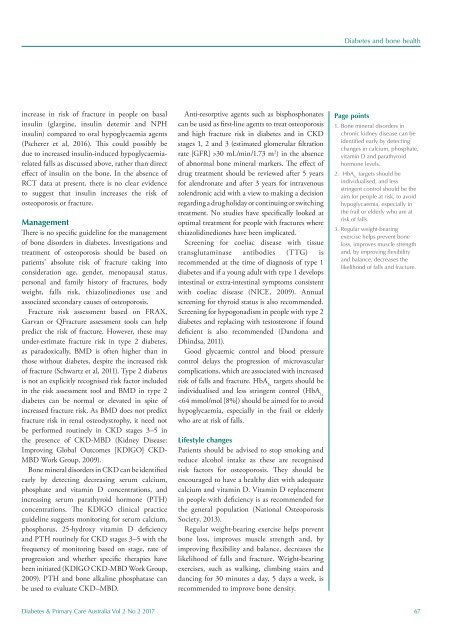DPCA2-2_issue_v3
Create successful ePaper yourself
Turn your PDF publications into a flip-book with our unique Google optimized e-Paper software.
Diabetes and bone health<br />
increase in risk of fracture in people on basal<br />
insulin (glargine, insulin detemir and NPH<br />
insulin) compared to oral hypoglycaemia agents<br />
(Pscherer et al, 2016). This could possibly be<br />
due to increased insulin-induced hypoglycaemiarelated<br />
falls as discussed above, rather than direct<br />
effect of insulin on the bone. In the absence of<br />
RCT data at present, there is no clear evidence<br />
to suggest that insulin increases the risk of<br />
osteoporosis or fracture.<br />
Management<br />
There is no specific guideline for the management<br />
of bone disorders in diabetes. Investigations and<br />
treatment of osteoporosis should be based on<br />
patients’ absolute risk of fracture taking into<br />
consideration age, gender, menopausal status,<br />
personal and family history of fractures, body<br />
weight, falls risk, thiazolinediones use and<br />
associated secondary causes of osteoporosis.<br />
Fracture risk assessment based on FRAX,<br />
Garvan or QFracture assessment tools can help<br />
predict the risk of fracture. However, these may<br />
under-estimate fracture risk in type 2 diabetes,<br />
as paradoxically, BMD is often higher than in<br />
those without diabetes, despite the increased risk<br />
of fracture (Schwartz et al, 2011). Type 2 diabetes<br />
is not an explicitly recognised risk factor included<br />
in the risk assessment tool and BMD in type 2<br />
diabetes can be normal or elevated in spite of<br />
increased fracture risk. As BMD does not predict<br />
fracture risk in renal osteodystrophy, it need not<br />
be performed routinely in CKD stages 3–5 in<br />
the presence of CKD-MBD (Kidney Disease:<br />
Improving Global Outcomes [KDIGO] CKD-<br />
MBD Work Group, 2009).<br />
Bone mineral disorders in CKD can be identified<br />
early by detecting decreasing serum calcium,<br />
phosphate and vitamin D concentrations, and<br />
increasing serum parathyroid hormone (PTH)<br />
concentrations. The KDIGO clinical practice<br />
guideline suggests monitoring for serum calcium,<br />
phosphorus, 25-hydroxy vitamin D deficiency<br />
and PTH routinely for CKD stages 3–5 with the<br />
frequency of monitoring based on stage, rate of<br />
progression and whether specific therapies have<br />
been initiated (KDIGO CKD-MBD Work Group,<br />
2009). PTH and bone alkaline phosphatase can<br />
be used to evaluate CKD–MBD.<br />
Anti-resorptive agents such as bisphosphonates<br />
can be used as first-line agents to treat osteoporosis<br />
and high fracture risk in diabetes and in CKD<br />
stages 1, 2 and 3 (estimated glomerular filtration<br />
rate [GFR] >30 mL/min/1.73 m 2 ) in the absence<br />
of abnormal bone mineral markers. The effect of<br />
drug treatment should be reviewed after 5 years<br />
for alendronate and after 3 years for intravenous<br />
zolendronic acid with a view to making a decision<br />
regarding a drug holiday or continuing or switching<br />
treatment. No studies have specifically looked at<br />
optimal treatment for people with fractures where<br />
thiazolidinediones have been implicated.<br />
Screening for coeliac disease with t<strong>issue</strong><br />
transglutaminase antibodies (TTG) is<br />
recommended at the time of diagnosis of type 1<br />
diabetes and if a young adult with type 1 develops<br />
intestinal or extra-intestinal symptoms consistent<br />
with coeliac disease (NICE, 2009). Annual<br />
screening for thyroid status is also recommended.<br />
Screening for hypogonadism in people with type 2<br />
diabetes and replacing with testosterone if found<br />
deficient is also recommended (Dandona and<br />
Dhindsa, 2011).<br />
Good glycaemic control and blood pressure<br />
control delays the progression of microvascular<br />
complications, which are associated with increased<br />
risk of falls and fracture. HbA 1c<br />
targets should be<br />
individualised and less stringent control (HbA 1c<br />
















